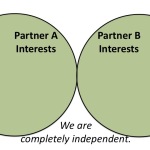In many different contexts, we see examples of competition contributing to higher performance. For competition in business, we can draw and important distinction between “good competition” and “bad competition,” which is sometimes under emphasized. As I understand it, “good competition” creates an environment where everyone has to “up their game” to remain competitive. As evidence that “the market works,” we would see examples of customers benefiting from competition because organizations have to work harder and smarter to remain in business. Conversely, “bad competition” creates an environment that destroys long-term value in the name of “winning” or “surviving.” In such scenarios, organizations harm the sector and themselves in a “race to the bottom.” Such scenarios also have organizations engage in ethically questionable behaviour to “win at all costs.”
To start, let’s assume that “good competition” is indeed possible. Let’s further assume that for it to work, it requires that parties share an understanding of what “good” they are trying to accomplish.
For businesses, making money is “good,” but so are other forms of benefit: safer automobile travel (Toyota), or sustainable practices (Unilever). Governments are expected to think more about the greater “good,” and as a specific illustration, let me use community health-care in Ontario. Let’s say that “good” in this context is “efficiency in delivering necessary services to patients,” or something that balances provision of necessary services within fiscal constraints. As is the current practice, the government-funded payment to service providers for some activities can be attached to a result or outcome: a service provider is given a lump sum to achieve a specific outcome (e.g. heal a wound). If they can complete the task more efficiently, profit is theirs. If it happens to take longer or more resources, the provider spends those resources, but can’t come back to the funder for more money. If this works, tax-payers in Ontario get better bang for their collective buck, and patients get high quality care; wins all around.
This same type of arrangement could work in a non-governemnt context as long as the service provider is at least partially interested in the same definition of “good.” This creates “good competition, and efficient organizations that do good work will succeed.
 The realm of “bad competition” can be peppered with “perverse incentives,” whereby, for example, a service provider could legitimately want a patient to stay sick, or at very least, err too much on the side of caution and so as to go wildly offside with a “fiscal responsibility” effort. This is the potentially very ugly underbelly of the public-sector contracting out to the private sector. In a consulting relationship, this can create, for example, an incentive to run-up the billable hours.
The realm of “bad competition” can be peppered with “perverse incentives,” whereby, for example, a service provider could legitimately want a patient to stay sick, or at very least, err too much on the side of caution and so as to go wildly offside with a “fiscal responsibility” effort. This is the potentially very ugly underbelly of the public-sector contracting out to the private sector. In a consulting relationship, this can create, for example, an incentive to run-up the billable hours.
Setting goals and objectives that promote shared accountability is extremely tricky. From my experience, the real trick is to align activity to a common purpose (e.g. the “good”), and I will go as far to say that without a shared interest, collaboration of this nature is impossible because the result will actually create “bad” competition.


Comments are closed